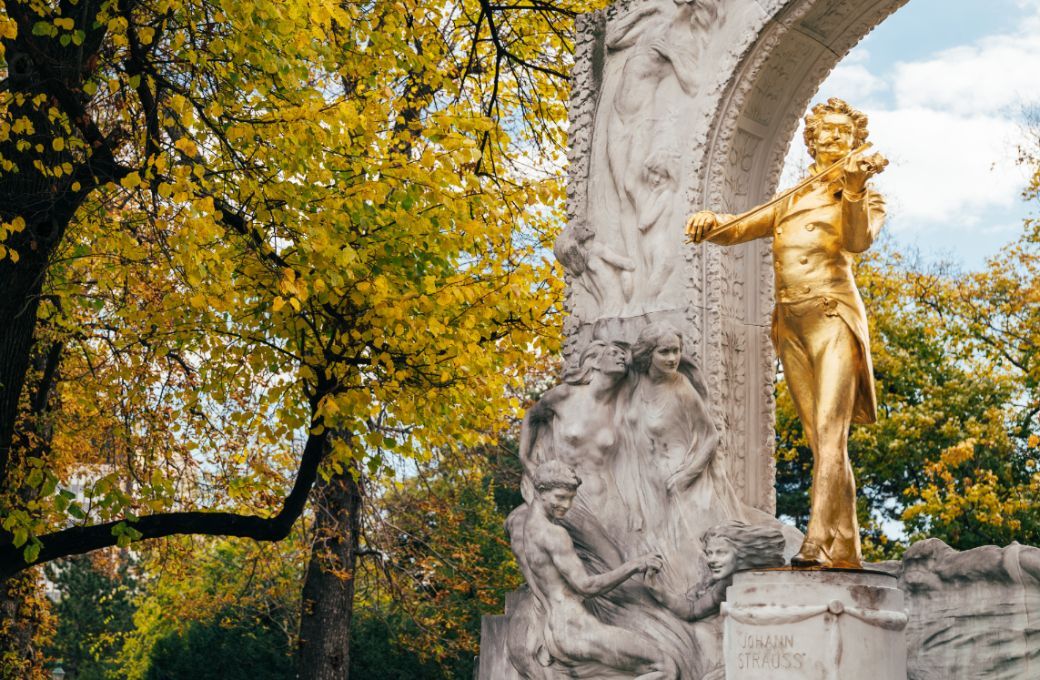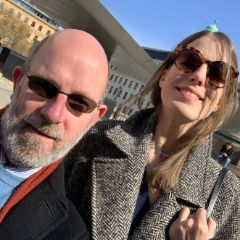Vienna. Synonymous with the waltz and, therefore, indelibly linked to the Strauss dynasty. When you land at Vienna International Airport, especially if you fly Austrian Airlines, the first music you’ll hear will be the strains of the world’s most famous waltz, The Blue Danube. Walk through the Stadtpark and you cannot miss the golden glimmer of the Strauss Monument, one of the city’s most iconic images. And every 1st January, the eyes of millions of people across the world are trained on the Golden Hall of the Musikverein, where the New Year’s Concert is traditionally stuffed with Strauss.
Head of the family was Johann Strauss I, who helped popularise waltzes, polkas and galops. His sons took up the compositional torch: Josef, Eduard and, most prolifically, the younger Johann, “the Waltz King”. Join us on a tour of Vienna in 3/4 time as we explore the world of Strauss in the City of Dreams.
Johann Strauss Monument
Stadtpark
One of Vienna’s most famous monuments stands in the middle of the Stadtpark: the golden Johann Strauss by sculptor Edmund Hellmer. Unveiled in June 1921 to the sound of The Blue Danube played by the Wiener Philharmoniker, the monument symbolises Vienna as the city of music like nothing else. It depicts Strauss as the violin-playing Waltz King, but not all that glitters is gold. The statue is made of bronze and gilded on the outside. [ES]

Strauss Wohnung
Praterstraße 54, 1020 Vienna
In 1863, Johann Strauss II moved into a first floor apartment on the fashionable Praterstraße, where he lived with his first wife, Jetty, a former opera singer, for seven years. Strauss composed The Blue Danube there in 1866 and it is one of several manuscripts on display in this small museum dedicated to the composer, along with portraits and objects, including a Bösendorfer baby grand piano – a gift for Strauss's 71st birthday in 1896. You can see Strauss’ tall standing desk – he composed standing up – plus an Amati violin and a harmonium. There is also a wonderful photograph of the neatly coiffured Strauss with a heavily bearded Brahms looking very jolly… and then you realise that Brahms was the younger of the two! [MP]
Die Fledermaus
Theater an der Wien, Staatsoper and Volksoper
Of Strauss’ 15 completed operettas, Die Fledermaus (The Bat) is easily the most popular. A farce, it tells the story of Dr Falke’s elaborate revenge for a prank his friend Gabriel von Eisenstein once played on him whereby he abandoned the doctor, drunk and dressed in a bat costume, in the city centre (hence the operetta’s surtitle The Revenge of the Bat). Falke ropes in Eisenstein’s wife, his maid, the prison governor and a Russian prince to trap Eisenstein in a compromising situation, but it’s all laughed off in the end, blamed on the effects of Champagne. Fledermaus is always in the repertory of the Staatsoper (in Otto Schenk’s classic staging) and the Volksoper, but this year has also seen a new production at the Theater an der Wien – where the work premiered in 1874 – by Stefan Herheim. [MP]
House of Strauss
Döblinger Hauptstraße 76 1190 Vienna
From 1837, the Casino Zögernitz in Döbling became one of Vienna’s most exclusive entertainment venues, with soirees every Wednesday and Saturday. The entire Strauss family performed there and several works, such as Johann Jnr’s Freiheitslieder (1848), were premiered there. After extensive restoration, Casino Zögernitz reopened as the House of Strauss in 2023, recapturing the spirit of the age via concerts, a restaurant and a museum. In the renovated ballroom, you can watch Johann Strauss II present his music virtually. The museum contains several interactive exhibits and is supported by QR code links. You can even upload your photo and perform in a Strauss operetta! [MP]
New Year’s Concert
Musikverein
The first New Year’s Concert took place during the Wiener Philharmoniker’s darkest chapter – a New Year’s Eve concert in 1939, an all-Strauss programme in the Musikverein conducted by Clemens Krauss, whose proceeds were donated entirely to the Nazi ‘Winter Relief Fund’ campaign. Since then, the concert has taken place on New Year’s Day, always dominated by the Strauss family. The Blue Danube is always the penultimate encore; the tradition of the orchestra shouting their New Year’s greeting during the introduction was initiated by concertmaster Willi Boskovsky, who led the concerts from 1955 to 1979. After a run under Lorin Maazel (1980-86), the Philharmoniker has invited different conductors to the podium. In 2026, Yannick Nézet-Séguin takes up the baton for the first time. Securing tickets is done by ballot. [MP]
Johann Strauss Museum – New Dimensions
Friedrichstraße 7, 1010 Vienna
For Strauss’ bicentenary, a new museum has opened. It’s a rather unusual museum in that there are no exhibits! Instead, visitors wear GPS-tracked audio-guide headphones and are led through darkened rooms where screens with videos and visuals bring Strauss’ story to life. Prints, posters, graphics, maps and individual modern objects are showcased effectively using mirrors. The exhibition covers an area of 900 square metres, divided over two floors. Would-be composers can create their own waltz on the composing machine and take it home as an audio file. [MP]
Palais Todesco
Kärntner Straße 51, 1010 Vienna
In 1861 – presumably with a glass of champagne and canapés in his hand – Strauss met his first wife Henriette “Jetty” Treffz at a Wiener Salon hosted by Sophie von Tedesco. At such an event, the cream of Viennese society gathered for intellectual discussion in a relaxed atmosphere and, of course, to meet potential spouses. Gustav Mahler met Alma at a similar salon. Today, the Palais hosts Gerstner, one of the most established Viennese cafés and confectioners, which celebrates its history with a Johann Strauss Chocolate: dark chocolate combined with finest marzipan and creamy gianduja hazelnut chocolate. [ES]
Haus der Musik (House of Music)
Seilerstätte 30, 1010 Vienna
How many of you sing, conduct or clap along at the New Year’s Concert? At the fabulous Haus der Musik, an interactive museum of sound and music, and only a few walking minutes away from the Staatsoper, you can do exactly that: conduct the Wiener Philharmoniker in Johann Strauss II’s The Blue Danube. On the top floor of the house – fun fact: Otto Nicolai founded the Philharmoniker at his place in 1842! – you can take up the baton, equipped with a motion sensor and, after a few tips from Zubin Mehta, the stage (or rather, the giant screen) is yours. But beware, if you can’t keep the beat, the orchestra will eventually stop playing and you’ll hear some grumpy complaints from the musicians. Mark and I have both tried our luck and although his technique is grander and more refined – think Herbert von Karajan – it was me who made it to the final bar… [ES]
Collection of Historic Musical Instruments
Weltmuseum, Heldenplatz
The Imperial State Rooms of the Neue Burg are a real treasure trove for music lovers. It displays historical musical instruments from five centuries, including instruments once played by, among others, Wolfgang Amadeus Mozart, Franz Liszt, Clara Schumann or Gustav Mahler. Hall XVII of the collections is dedicated to Johann Strauss. While objects such as the Polyphon or the Lebende Bild depict the musical traditions of the time, you can also find the Geissenhof violin, used in his orchestras, and the Schweighofer grand piano, which wasplayed by Strauss himself. [ES]
Grave of Johann Strauss II
Zentralfriedhof
Austrians, and especially the Viennese, have a special kind of humour and relationship with death and funerals. It’s slightly macabre, but also brutally honest and it ultimately celebrates life. If you are open to the idea, why not take a lovely walk through the Zentralfriedhof (Central Cemetery)? In the immediate vicinity of Ludwig van Beethoven, Franz Schubert and Johannes Brahms, you can find the Waltz King, who was laid to rest in a grave of honour by the City of Vienna in 1899. The gravestone is full of references to the life and work of Johann Strauss: dancing and singing figures, a Danube mermaid, bats and Strauss himself with his typical twirled moustache. [ES]
Bonus: Johann Strauss Audio Walk
Reminders of the Waltz King can be found all over Vienna and with the Johann Strauss Audio Walk in the city guide app ivie you can follow in his footsteps.
Click here for more information.


